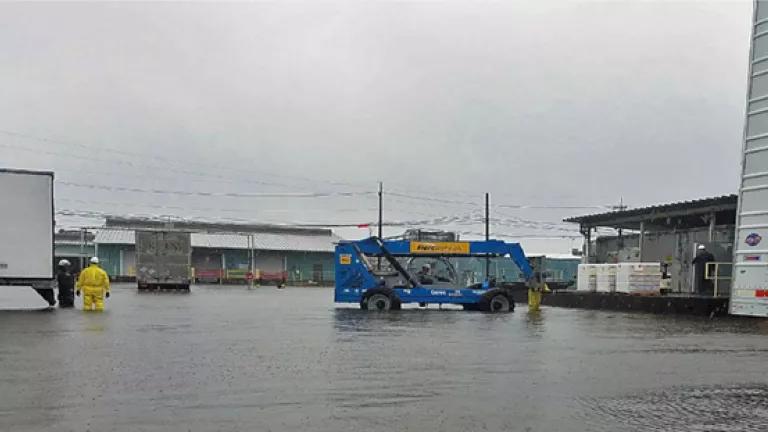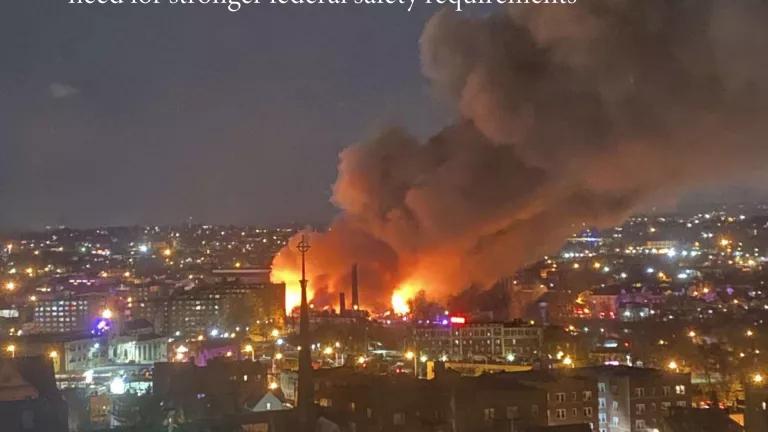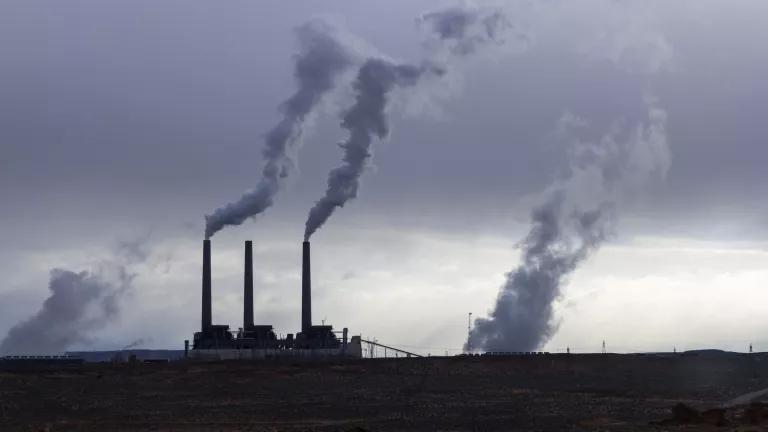EPA Proposal Too Tepid to Address Dangerous Chemical Spills
The proposal covers only those facilities that are capable of storing a threshold quantity of hazardous substances and are also within one-half mile of a waterway protected by the Clean Water Act.

Floodwaters at the Arkema Crosby facility after Hurricane Harvey in 2017
U.S. Chemical Safety Board
Thirty years after it was first required to do so, the U.S. Environmental Protection Agency (EPA) has finally proposed a rule to fill part of a gaping hole in the regulations meant to protect our nation’s waters from chemical spills. As the saying goes, better late than never – except that in this case, EPA’s delay has had severe consequences.
Thousands of facilities that store hazardous chemicals are located in communities that are in close proximity to waterways and in flood-prone areas, and yet none are required by federal regulations to have plans to prevent and respond to worst case scenario spills of these substances into waterways. As a result, hazardous chemicals spill into waters providing drinking water and critical wildlife habitat year after year. For example, Hurricane Harvey, which struck Houston’s dense zone of flood-susceptible facilities storing hazardous substances, caused numerous facilities to release harmful chemicals, harming first responders, the surrounding community, and the environment. A few years earlier, a leak at a chemical storage facility along the Elk River in West Virginia left 300,000 people without drinking water for days.
These types of disasters highlight two pressing environmental crises – climate change and environmental injustice. Disasters will only become more common as climate change increases the frequency and severity of severe weather. And as with so many other environmental harms, the burden of exposure to toxic chemicals from these disasters is primarily shouldered by low-income communities of color, who are nearly twice as likely as white populations to live within one mile of a hazardous chemical facility.
It didn’t need to be this way. Since 1972, the Clean Water Act has required EPA to issue regulations requiring industrial facilities that store toxic chemicals near water bodies to take measures to prevent chemical spills. After decades of inaction by EPA, NRDC, the Environmental Justice Health Alliance for Chemical Policy Reform (EJHA), and People Concerned About Chemical Safety sued. Although EPA agreed to issue the required regulations, it unlawfully abdicated its responsibility. Our coalition kept up the fight, focusing on provisions in the 1990 amendments to the Clean Water Act directing EPA to issue regulations requiring robust hazardous substance spill response planning for the most dangerous chemical facilities – which, because of their proximity to water, pose a serious threat to human health and the environment. As with the spill prevention regulations, EPA had sat on its hands for decades and failed to issue these “worst case spills” regulations. In the face of this inaction, NRDC, EJHA, and Clean Water Action again filed suit against EPA, this time for its failure to require spill response planning. And on March 12, 2020, the parties entered a consent decree that resolved the lawsuit and required EPA to issue proposed regulations for worst case spills of hazardous substances by March 2022 and finalize those regulations within the following 2.5 years.
Last month, EPA at long last published the proposed worst case spills rule. The proposal is a crucial first step towards ensuring that chemical facilities are able to prevent and respond to worst case spills. But our coalition will be pushing EPA to strengthen the final rule so that it covers the right facilities, fully accounts for the risks of a changing climate, and provides maximal protection to environmental justice communities.
Because the proposal is concerned with “worst case” spills, it covers only those facilities that are capable of storing a threshold quantity of hazardous substances and are also within one-half mile of a waterway protected by the Clean Water Act. If a worst-case spill from one of those facilities would cause substantial harm to wildlife, public drinking water systems, and/or recreation areas, the facility must prepare a Facility Response Plan. Those plans, which will be submitted to EPA, will contain critical information for ensuring facilities can prevent and respond to a worst-case spill.
The proposed rule takes some important steps to address long-standing concerns. The facilities it covers will be required to make plans for responding to worst case spills that take into account “impacts to communities with environmental justice concerns” and “impacts of climate change.” The rule also includes important provisions to help ensure that facilities that pose risks to environmental justice communities will be covered: EPA retains wide authority to require facility response plans for facilities located near environmental justice communities, and stakeholders can petition EPA to cover facilities that should be subject to the rule’s requirements.
But the proposal has gaps and should be stronger. Some of the most important gaps include that the proposal would only cover facilities that store a very large amount of a single hazardous substance. By EPA’s own estimate, setting the quantity so high means that over 100,000 facilities that store dangerous amounts of hazardous substances will not be covered. The proposal would also ignore the total quantity of different chemicals stored by a facility, so a facility storing a smaller amount of multiple dangerous chemicals may not be covered even though in the aggregate it may be storing a significant amount of hazardous chemicals. And the proposal’s requirement that facilities will only be covered if they are within a half-mile of a waterway does not reflect the realities of expanding flood zones in a changing climate.
Although the proposal commits to making some information public, the final rule should commit to fuller transparency and consultation so that those who may be impacted by spills – especially environmental justice communities and public water systems – have the information they need to protect themselves. Finally, the proposal does not fix other holes in the regulations meant to protect our waters: it only applies to facilities storing Clean Water Act hazardous substances, an outdated list of around 300 chemicals that does not include thousands of other toxic substances (including those released in the Elk River disaster), and it fails to reverse EPA’s unlawful decision to not issue regulations that prevent hazardous spills in the first place.
NRDC and our partners will be filing comments on these and other issues at the end of May, and we will also be providing opportunities for people concerned about toxic spills to weigh in. Though EPA’s proposed rule is long overdue and does not go far enough to protect our waterways and the environmental justice communities who rely on them, the proposal is a critical first step to safeguarding our waters in a changing climate.





